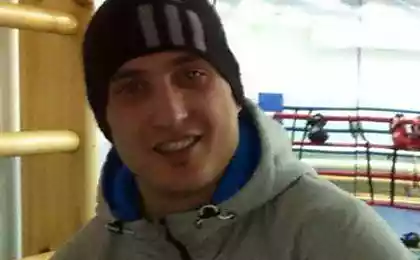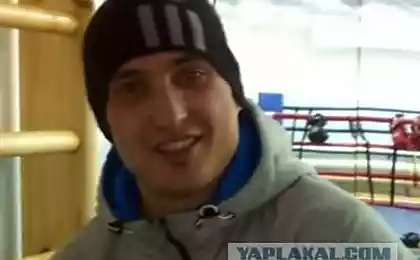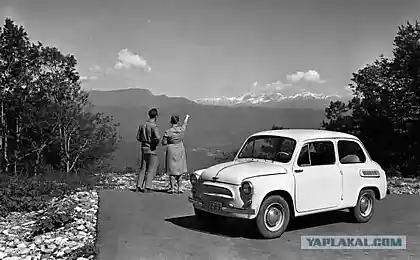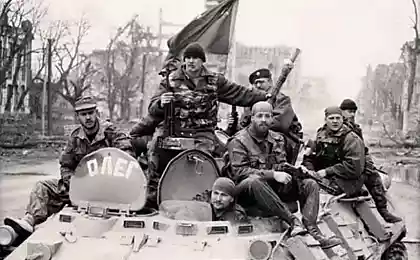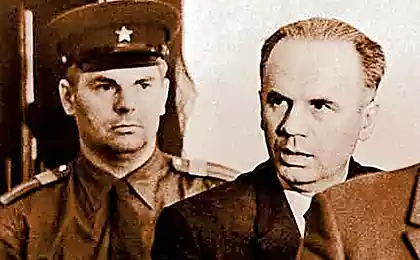907
45 years ago, the history of "Zhiguli" + video "Small car big country"!
45 years ago began the history of "Zhiguli»
+ Video "Small car big country»!

45 years ago, May 4, 1966 an agreement was signed between Fiat and the Soviet Union to establish a car factory on the Volga. Since then, the Soviet Union was the mass motorization.
For a qualitative leap forward was to destroy the Soviet state economic "iron curtain". Italy is the most promising direction of the negotiations. There were very strong socialist sentiments. The head of the local "left" Palmiro Togliatti was a great friend of the USSR. President largest oil company Eni Enrico Matei was a fighter and anti-fascist resistance. In addition, since the 1920s the USSR had experience of economic ties with the same factory Fiat.
Signing the letter of intent the parties took place in the Centro Storico - Memorial Exhibition Hall of Fiat in the center of Turin.
May 28, 1962 in Moscow, the largest commercial and industrial exhibition in Italy. Guests brought samples of serial production, layout and even automobile car concept Ghia Selena. The delegation arrived the president of Fiat Vittorio Valletta.
For sensing relations in an unofficial visit to Italy at the beginning of July 1962 I went to the 1st Deputy Prime Minister Alexei Kosygin. He met with the business elite of the country - the same Matei, as well as the president of FIAT and Olivetti Valletta, president of the eponymous company for the production of office equipment and electronic computers. With the approval of the Prime Minister of the USSR Nikita Khrushchev, Kosygin also met with Italian President Antonio Segni and Prime Minister Amintore Fanfani.
One of the main topics of the talks was the construction of a modern car factory in the Soviet Union the capacity of 600 thousand cars per year. First Kosygin put on the Politburo question of shortage of working capital in the country. Personal savings shortly after the currency reform of 1961, popularly known as the "Khrushchev," exceeded 60 billion rubles. The issue of mass car would allow the ruble to remove from the egg capsules.
Interestingly, Khrushchev, in general, to maintain contacts with Italy, the idea of the mass of the car for the citizens of the Soviet Union did not approve, believing that it will increase in proprietary sentiment.
October 16, 1964 at the Presidium of the CC CPSU Khrushchev removed. Kosygin called his management style "is not Leninist." However, opponents of mass motorization in the Central Committee by the Italians was not lowered. Defense Minister Dmitry Ustinov persuaded that the domestic "defense industry" in a position to release a competitive car itself. Obviously, in the Central Committee of the struggle for a lot of money, which was to allocate to the program. Ustinov succeeded in organizing the production of passenger cars in Izhevsk.
But I chose the Fiat-124, recognizes the "Car of 1967". Along with the sedan and wagon we have improved the performance sedan that have become, respectively, the VAZ-2101, VAZ-2102 and VAZ-2103.
In late June 1965 in Moscow newcomers Vittorio Valletta. It signed an agreement on scientific and technical cooperation in the field of automotive company between Fiat and the State Committee on Science and Technology of the USSR in order to create an industrial complex to produce 600,000 cars a year.
After the removal of Khrushchev, Kosygin was appointed Chairman of the USSR Council of Ministers. Therefore, in principle the intention to buy a foreign car factory could hardly change. However, this could prevent opponents of the deal abroad. Not by chance through the Soviet Ambassador in Rome Semen Pavlovich Kozyrev was launched misinformation about the negotiations with Renault.
Kosygin as too large figure could attract unhealthy attention to the opponents of the agreement. According to the instructions of the talks with the leaders of Valletta Fiat and the Agnelli as the personal representative of the Chairman Council of Ministers continued Jermaine M. Gvishiani. He served as deputy chairman of the Committee on Science and Technology of the USSR (Soviet Union SCCT). Gvishiani Kosygin was son in law, but this is the rare case when Kosygin not only promoted a relative, but held back his career.
As recalled Fiat-leading designer Dante Giacosa 124 in the Soviet delegation were supporters of the front-drive layout and considered as an alternative to Autobianchi Primula (fiatovsky project 09).
Fourth of July 1966 in fiatovskom Centro Storico in the presence of Gvishiani, Agnelli Minister Kozyrev and the automotive industry of the USSR Alexander Tarasov and Vittorio Valletta signed a protocol on the establishment of the Soviet Union industrial complex enterprises for the production of cars.
At the same time, the Italian credit bank Vneshtorgbank target allocated a loan of $ 320 million for a term of eight years. This was the beginning of the most successful commercial agreement in the history of both countries. In July 1966, the landfill near Dmitrov us arrived first Fiat-124 - a prototype of the future "Lada". August 15, 1966 General Agreement was signed between Fiat and of Foreign Trade of the USSR "On cooperation in the development of car design, automotive design and construction of the plant in the Soviet Union».
+ Video "Small car big country»!

45 years ago, May 4, 1966 an agreement was signed between Fiat and the Soviet Union to establish a car factory on the Volga. Since then, the Soviet Union was the mass motorization.
For a qualitative leap forward was to destroy the Soviet state economic "iron curtain". Italy is the most promising direction of the negotiations. There were very strong socialist sentiments. The head of the local "left" Palmiro Togliatti was a great friend of the USSR. President largest oil company Eni Enrico Matei was a fighter and anti-fascist resistance. In addition, since the 1920s the USSR had experience of economic ties with the same factory Fiat.
Signing the letter of intent the parties took place in the Centro Storico - Memorial Exhibition Hall of Fiat in the center of Turin.
May 28, 1962 in Moscow, the largest commercial and industrial exhibition in Italy. Guests brought samples of serial production, layout and even automobile car concept Ghia Selena. The delegation arrived the president of Fiat Vittorio Valletta.
For sensing relations in an unofficial visit to Italy at the beginning of July 1962 I went to the 1st Deputy Prime Minister Alexei Kosygin. He met with the business elite of the country - the same Matei, as well as the president of FIAT and Olivetti Valletta, president of the eponymous company for the production of office equipment and electronic computers. With the approval of the Prime Minister of the USSR Nikita Khrushchev, Kosygin also met with Italian President Antonio Segni and Prime Minister Amintore Fanfani.
One of the main topics of the talks was the construction of a modern car factory in the Soviet Union the capacity of 600 thousand cars per year. First Kosygin put on the Politburo question of shortage of working capital in the country. Personal savings shortly after the currency reform of 1961, popularly known as the "Khrushchev," exceeded 60 billion rubles. The issue of mass car would allow the ruble to remove from the egg capsules.
Interestingly, Khrushchev, in general, to maintain contacts with Italy, the idea of the mass of the car for the citizens of the Soviet Union did not approve, believing that it will increase in proprietary sentiment.
October 16, 1964 at the Presidium of the CC CPSU Khrushchev removed. Kosygin called his management style "is not Leninist." However, opponents of mass motorization in the Central Committee by the Italians was not lowered. Defense Minister Dmitry Ustinov persuaded that the domestic "defense industry" in a position to release a competitive car itself. Obviously, in the Central Committee of the struggle for a lot of money, which was to allocate to the program. Ustinov succeeded in organizing the production of passenger cars in Izhevsk.
But I chose the Fiat-124, recognizes the "Car of 1967". Along with the sedan and wagon we have improved the performance sedan that have become, respectively, the VAZ-2101, VAZ-2102 and VAZ-2103.
In late June 1965 in Moscow newcomers Vittorio Valletta. It signed an agreement on scientific and technical cooperation in the field of automotive company between Fiat and the State Committee on Science and Technology of the USSR in order to create an industrial complex to produce 600,000 cars a year.
After the removal of Khrushchev, Kosygin was appointed Chairman of the USSR Council of Ministers. Therefore, in principle the intention to buy a foreign car factory could hardly change. However, this could prevent opponents of the deal abroad. Not by chance through the Soviet Ambassador in Rome Semen Pavlovich Kozyrev was launched misinformation about the negotiations with Renault.
Kosygin as too large figure could attract unhealthy attention to the opponents of the agreement. According to the instructions of the talks with the leaders of Valletta Fiat and the Agnelli as the personal representative of the Chairman Council of Ministers continued Jermaine M. Gvishiani. He served as deputy chairman of the Committee on Science and Technology of the USSR (Soviet Union SCCT). Gvishiani Kosygin was son in law, but this is the rare case when Kosygin not only promoted a relative, but held back his career.
As recalled Fiat-leading designer Dante Giacosa 124 in the Soviet delegation were supporters of the front-drive layout and considered as an alternative to Autobianchi Primula (fiatovsky project 09).
Fourth of July 1966 in fiatovskom Centro Storico in the presence of Gvishiani, Agnelli Minister Kozyrev and the automotive industry of the USSR Alexander Tarasov and Vittorio Valletta signed a protocol on the establishment of the Soviet Union industrial complex enterprises for the production of cars.
At the same time, the Italian credit bank Vneshtorgbank target allocated a loan of $ 320 million for a term of eight years. This was the beginning of the most successful commercial agreement in the history of both countries. In July 1966, the landfill near Dmitrov us arrived first Fiat-124 - a prototype of the future "Lada". August 15, 1966 General Agreement was signed between Fiat and of Foreign Trade of the USSR "On cooperation in the development of car design, automotive design and construction of the plant in the Soviet Union».




